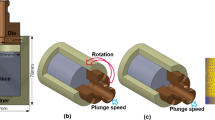Abstract
Channeling cracks in brittle thin films have been observed to be a key reliability issue for advanced interconnects and other integrated structures. Most theoretical studies to date have assumed no delamination at the interface, while experiments have observed channel cracks both with and without interfacial delamination. This paper analyzes the effect of interfacial delamination on the fracture condition of brittle thin films on elastic substrates. It is found that, depending on the elastic mismatch and interface toughness, a channel crack may grow with no delamination, with a stable delamination, or with unstable delamination. For a film on a relatively compliant substrate, a critical interface toughness is predicted, which separates stable and unstable delamination. For a film on a relatively stiff substrate, however, a channel crack grows with no delamination when the interface toughness is greater than a critical value, while stable delamination along with the channel crack is possible only in a small range of interface toughness for a specific elastic mismatch. An effective energy release rate for the steady-state growth of a channel crack is defined to account for the influence of interfacial delamination on both the fracture driving force and the resistance, which can be significantly higher than the energy release rate assuming no delamination.
Similar content being viewed by others
References
Ambrico JM, Begley MR (2002) The role of initial flaw size, elastic compliance and plasticity in channel cracking of thin films. Thin Solid Films 419: 144–153
Beuth JL (1992) Cracking of thin bonded film in residual tension. Int J Solids Struct 29: 63–191
Cordero N, Yoon J, Suo Z (2007) Channel cracks in hermetic coating consisting of organic and inorganic layers. Appl Phys Lett 90: 111910
Cotterell B (1965) On brittle fracture paths. Int J Fract Mech 1: 96–103
Cotterell B, Rice JR (1980) Slightly curved or kinked cracks. Int J Fract 16: 155–169
Dodabalapur A (2006) Organic and polymer transistors for electronics. Mater Today 9: 24–30
Gao H (2006) Application of fracture mechanics concepts to hierarchical biomechanics of bone and bone-like materials. Int J Fract 138: 101–137
Hayashi K, Nemat-Nasser S (1981) Energy-release rate and crack kinking under combined loading. J Appl Mech 48: 520–524
He MY, Hutchinson JW (1989a) Crack deflection at an interface between dissimilar elastic materials. Int J Solids Struct 25: 1053–1067
He MY, Hutchinson JW (1989b) Kinking of a crack out of an interface. J Appl Mech 56: 270–278
He J, Xu G, Suo Z (2004) Experimental determination of crack driving forces in integrated structures. In Proc 7th int workshop on stress-induced phenomena in metallization, Austin, Texas, 14–16 June 2004, pp 3–14
Ho PS, Wang G, Ding M, Zhao JH, Dai X (2004) Reliability issues for flip-chip packages. Microelectronics Reliability 44: 719–737
Huang R, Prevost JH, Suo Z (2002) Loss of constraint on fracture in thin film structures due to creep. Acta Mater 50: 4137–4148
Huang R, Prevost JH, Huang ZY, Suo Z (2003) Channel-cracking of thin films with the extended finite element method. Eng Frac Mech 70: 2513–2526
Hutchinson JW, Suo Z (1992) Mixed mode cracking in layered materials. Adv Appl Mech 29: 63–191
Khang DY, Jiang HQ, Huang Y, Rogers JA (2006) A stretchable form of single-crystal silicon for high-performance electronics on rubber substrate. Science 311: 208–212
Li T, Suo Z (2007) Ductility of thin metal films on polymer substrates modulated by interfacial adhesion. Int J Solids Struct 44: 1696–1705
Liu XH, Lane MW, Shaw TM, Liniger EG, Rosenberg RR, Edelstein DC (2004) Low-k BEOL mechanical modeling. In Proc advanced metallization conference, pp 361–367
Liu XH, Lane MW, Shaw TM, Simonyi E (2007) Delamination in patterned films. Int J Solids Struct 44: 1706–1718
Nakamura T, Kamath SM (1992) Three-dimensional effects in thin-film fracture mechanics. Mech Mater 13: 67–77
Rice JR (1988) Elastic fracture concepts for interfacial cracks. J Appl Mech 55: 98–103
Suo Z (2003) Reliability of interconnect structures. In: Gerberich W, Yang W (eds) Volume 8: interfacial and nanoscale failure of comprehensive structural integrity (Milne I, Ritchie RO, Karihaloo B, editors-in-chief). Elsevier, Amsterdam, pp 265–324
Suo Z, Hutchinson JW (1990) Interface crack between two elastic layers. Int J Fract 43: 1–18
Suo Z, Prevost JH, Liang J (2003) Kinetics of crack initiation and growth in organic-containing integrated structures. J Mech Phys Solids 51: 2169–2190
Tsui TY, McKerrow AJ, Vlassak JJ (2005) Constraint effects on thin film channel cracking behavior. J Mater Res 20: 2266–2273
Tsui TY, McKerrow AJ, Vlassak JJ (2006) The effect of water diffusion on the adhesion of organosilicate glass film stacks. J Mech Phys Solids 54: 887–903
Vlassak JJ (2003) Channel cracking in thin films on substrates of finite thickness. Int J Fract 119/120: 299–323
Wagner S, Lacour SP, Jones J, Hsu PI, Sturm J, Li T, Suo Z (2004) Electronic skin: architecture and components. Physica E 25: 326–334
Ye T, Suo Z, Evans AG (1992) Thin film cracking and the roles of substrate and interface. Int J Solids Struct 29: 2639–2648
Yu HH, He MY, Hutchinson JW (2001) Edge effects in thin film delamination. Acta Mater 49: 93–107
Zak AR, Williams ML (1963) Crack point stress singularities at a bi-material interface. J Appl Mech 30: 142–143
Author information
Authors and Affiliations
Corresponding author
Rights and permissions
About this article
Cite this article
Mei, H., Pang, Y. & Huang, R. Influence of interfacial delamination on channel cracking of elastic thin films. Int J Fract 148, 331–342 (2007). https://doi.org/10.1007/s10704-008-9205-7
Received:
Accepted:
Published:
Issue Date:
DOI: https://doi.org/10.1007/s10704-008-9205-7




